2014 NISSAN ROGUE oil
[x] Cancel search: oilPage 402 of 442
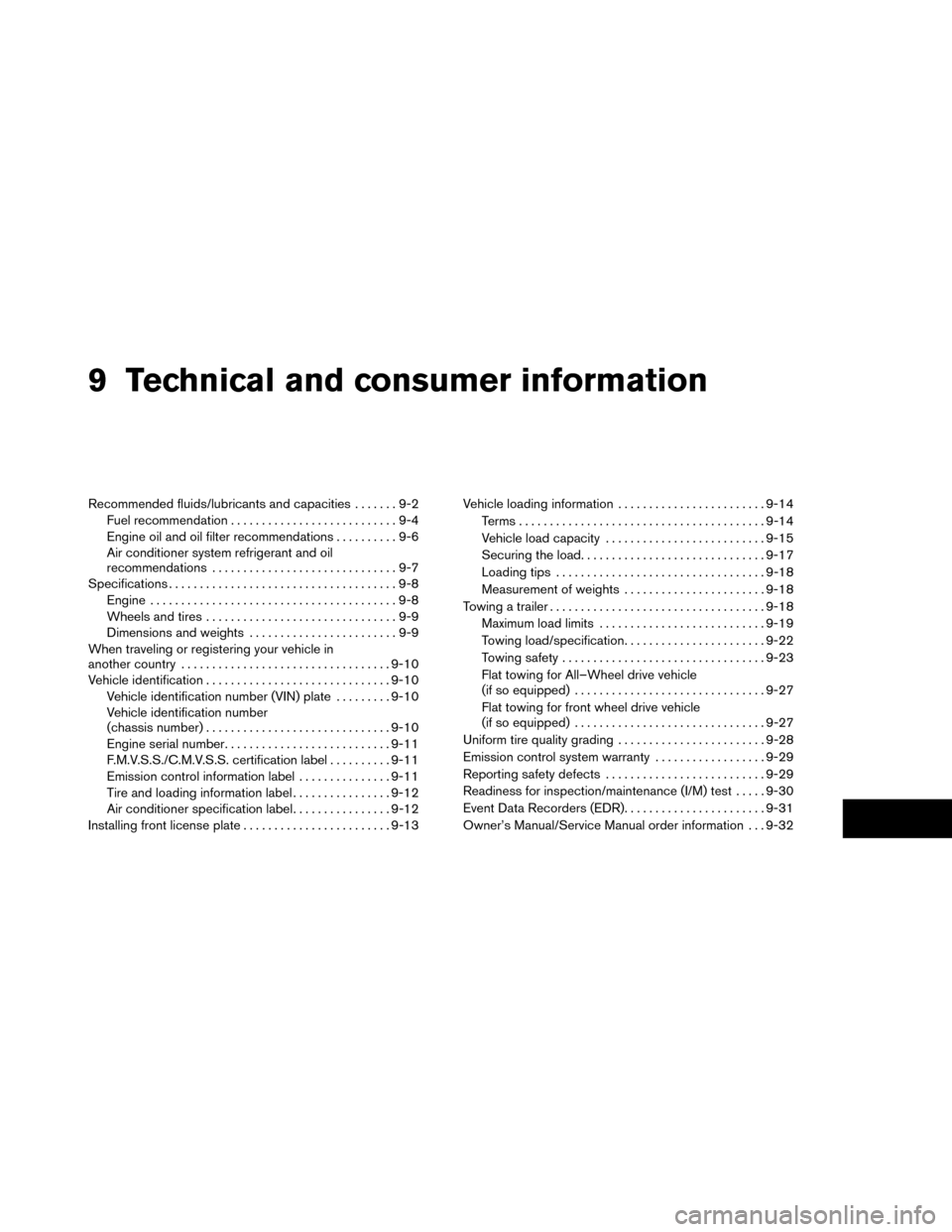
9 Technical and consumer information
Recommended fluids/lubricants and capacities . ......9-2
Fuel recommendation ...........................9-4
Engine oil and oil filter recommendations ..........9-6
Air conditioner system refrigerant and oil
recommendations ..............................9-7
Specifications .....................................9-8
Engine ........................................9-8
Wheels and tires ...............................9-9
Dimensions and weights ........................9-9
When traveling or registering your vehicle in
another country .................................. 9-10
Vehicle identification .............................. 9-10
Vehicle identification number (VIN) plate .........9-10
Vehicle identification number
(chassis number) .............................. 9-10
Engine serial number ........................... 9-11
F.M.V.S.S./C.M.V.S.S. certification label ..........9-11
Emission control information label ...............9-11
Tire and loading information label ................9-12
Air conditioner specification label ................9-12
Installing front license plate ........................9-13Vehicle loading information
........................9-14
Terms ........................................ 9-14
Vehicle load capacity .......................... 9-15
Securing the load .............................. 9-17
Loading tips . . . ............................... 9-18
Measurement of weights .......................9-18
Towing a trailer ................................... 9-18
Maximum load limits ........................... 9-19
Towing load/specification .......................9-22
Towing safety ................................. 9-23
Flat towing for All–Wheel drive vehicle
(if so equipped) ............................... 9-27
Flat towing for front wheel drive vehicle
(if so equipped) ............................... 9-27
Uniform tire quality grading ........................9-28
Emission control system warranty ..................9-29
Reporting safety defects .......................... 9-29
Readiness for inspection/maintenance (I/M) test .....9-30
Event Data Recorders (EDR) .......................9-31
Owner’s
Manual/Service Manual order information . . . 9-32
Page 403 of 442
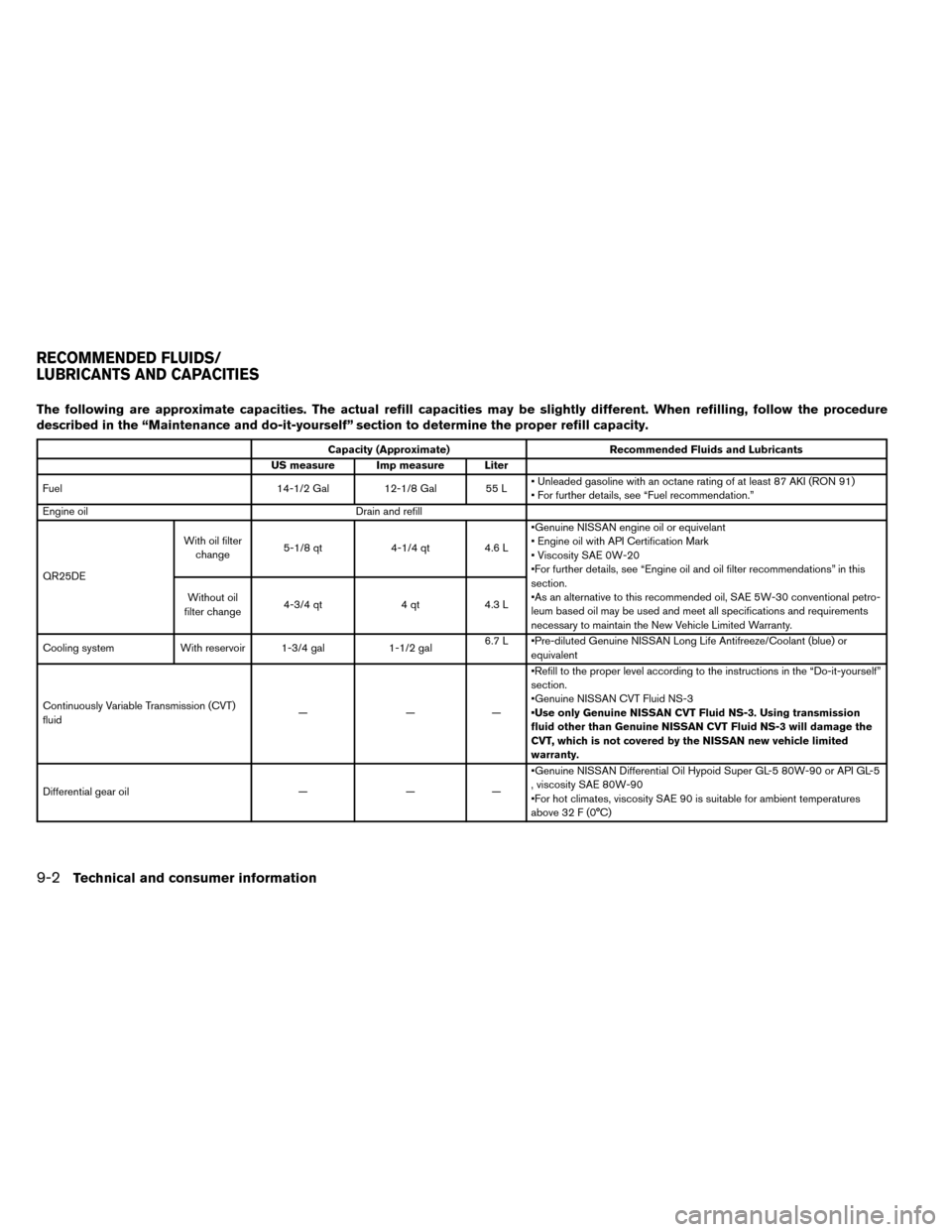
The following are approximate capacities. The actual refill capacities may be slightly different. When refilling, follow the procedure
described in the “Maintenance and do-it-yourself” section to determine the proper refill capacity.
Capacity (Approximate)Recommended Fluids and Lubricants
US measure Imp measure Liter
Fuel 14-1/2 Gal12-1/8 Gal 55 L • Unleaded gasoline with an octane rating of at least 87 AKI (RON 91)
• For further details, see “Fuel recommendation.”
Engine oil Drain and refill
QR25DE With oil filter
change 5-1/8 qt
4-1/4 qt4.6 L•Genuine NISSAN engine oil or equivelant
• Engine oil with API Certification Mark
• Viscosity SAE 0W-20
•For further details, see “Engine oil and oil filter recommendations” in this
section.
•As an alternative to this recommended oil, SAE 5W-30 conventional petro-
leum based oil may be used and meet all specifications and requirements
necessary to maintain the New Vehicle Limited Warranty.
Without oil
filter change 4-3/4 qt
4 qt4.3 L
Cooling system With reservoir 1-3/4 gal 1-1/2 gal6.7 L •Pre-diluted Genuine NISSAN Long Life Antifreeze/Coolant (blue) or
equivalent
Continuously Variable Transmission (CVT)
fluid ———•Refill to the proper level according to the instructions in the “Do-it-yourself”
section.
•Genuine NISSAN CVT Fluid NS-3
•Use only Genuine NISSAN CVT Fluid NS-3. Using transmission
fluid other than Genuine NISSAN CVT Fluid NS-3 will damage the
CVT, which is not covered by the NISSAN new vehicle limited
warranty.
Differential gear oil ———•Genuine NISSAN Differential Oil Hypoid Super GL-5 80W-90 or API GL-5
, viscosity SAE 80W-90
•For hot climates, viscosity SAE 90 is suitable for ambient temperatures
above 32 F (0°C)
RECOMMENDED FLUIDS/
LUBRICANTS AND CAPACITIES
9-2Technical and consumer information
Page 404 of 442
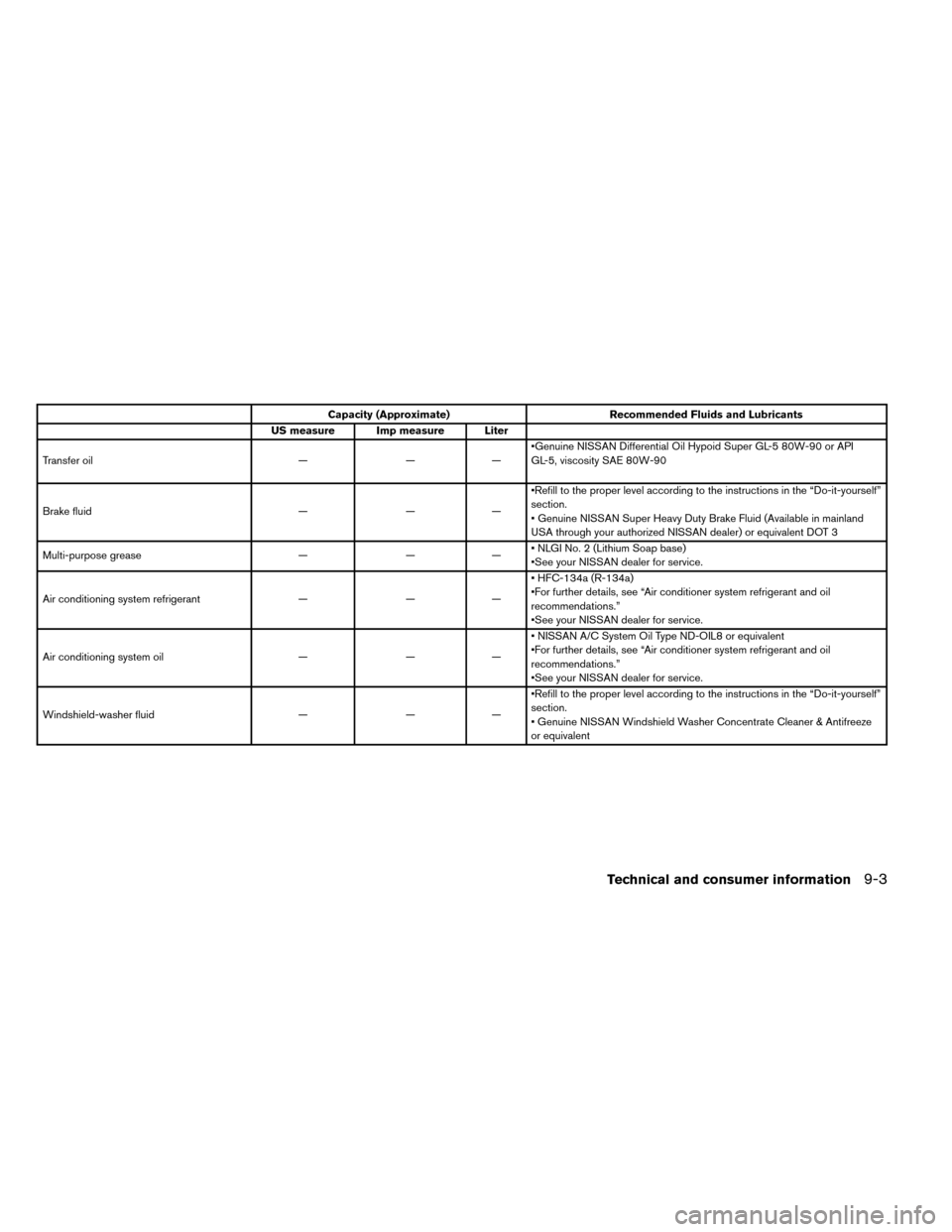
Capacity (Approximate)Recommended Fluids and Lubricants
US measure Imp measure Liter
Transfer oil ———•Genuine NISSAN Differential Oil Hypoid Super GL-5 80W-90 or API
GL-5, viscosity SAE 80W-90
Brake fluid ———•Refill to the proper level according to the instructions in the “Do-it-yourself”
section.
• Genuine NISSAN Super Heavy Duty Brake Fluid (Available in mainland
USA through your authorized NISSAN dealer) or equivalent DOT 3
Multi-purpose grease ———• NLGI No. 2 (Lithium Soap base)
•See your NISSAN dealer for service.
Air conditioning system refrigerant ———• HFC-134a (R-134a)
•For further details, see “Air conditioner system refrigerant and oil
recommendations.”
•See your NISSAN dealer for service.
Air conditioning system oil ———• NISSAN A/C System Oil Type ND-OIL8 or equivalent
•For further details, see “Air conditioner system refrigerant and oil
recommendations.”
•See your NISSAN dealer for service.
Windshield-washer fluid ———•Refill to the proper level according to the instructions in the “Do-it-yourself”
section.
• Genuine NISSAN Windshield Washer Concentrate Cleaner & Antifreeze
or equivalent
Technical and consumer information9-3
Page 407 of 442
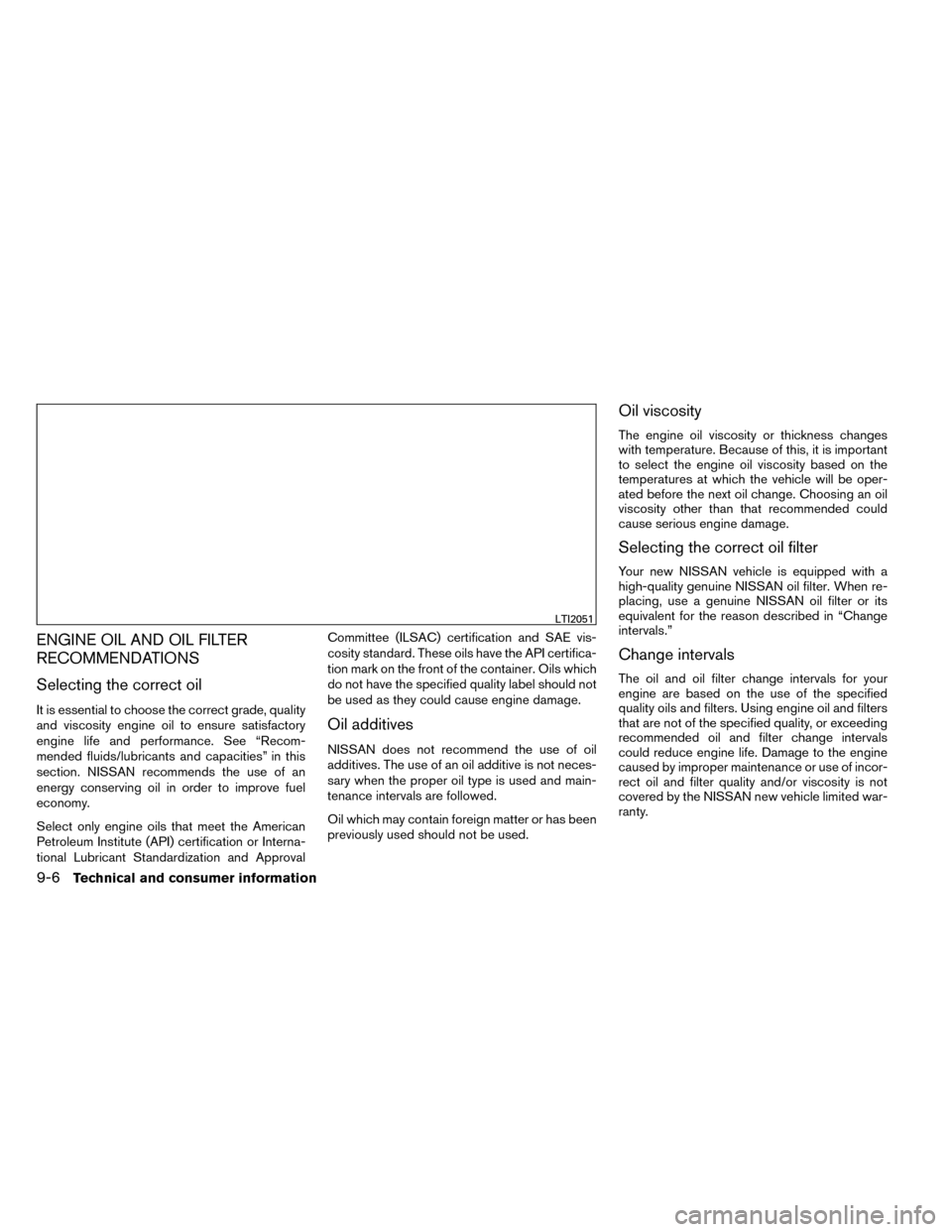
ENGINE OIL AND OIL FILTER
RECOMMENDATIONS
Selecting the correct oil
It is essential to choose the correct grade, quality
and viscosity engine oil to ensure satisfactory
engine life and performance. See “Recom-
mended fluids/lubricants and capacities” in this
section. NISSAN recommends the use of an
energy conserving oil in order to improve fuel
economy.
Select only engine oils that meet the American
Petroleum Institute (API) certification or Interna-
tional Lubricant Standardization and ApprovalCommittee (ILSAC) certification and SAE vis-
cosity standard. These oils have the API certifica-
tion mark on the front of the container. Oils which
do not have the specified quality label should not
be used as they could cause engine damage.Oil additives
NISSAN does not recommend the use of oil
additives. The use of an oil additive is not neces-
sary when the proper oil type is used and main-
tenance intervals are followed.
Oil which may contain foreign matter or has been
previously used should not be used.
Oil viscosity
The engine oil viscosity or thickness changes
with temperature. Because of this, it is important
to select the engine oil viscosity based on the
temperatures at which the vehicle will be oper-
ated before the next oil change. Choosing an oil
viscosity other than that recommended could
cause serious engine damage.
Selecting the correct oil filter
Your new NISSAN vehicle is equipped with a
high-quality genuine NISSAN oil filter. When re-
placing, use a genuine NISSAN oil filter or its
equivalent for the reason described in “Change
intervals.”
Change intervals
The oil and oil filter change intervals for your
engine are based on the use of the specified
quality oils and filters. Using engine oil and filters
that are not of the specified quality, or exceeding
recommended oil and filter change intervals
could reduce engine life. Damage to the engine
caused by improper maintenance or use of incor-
rect oil and filter quality and/or viscosity is not
covered by the NISSAN new vehicle limited war-
ranty.
LTI2051
9-6Technical and consumer information
Page 408 of 442

Your engine was filled with a high-quality engine
oil when it was built. You do not have to change
the oil before the first recommended change
interval. Oil and filter change intervals depend
upon how you use your vehicle.
Operation under the following conditions may
require more frequent oil and filter changes:● repeated short distance driving at cold out-
side temperatures
● driving in dusty conditions
● extensive idling
● towing a trailer
● stop and go commuting
Refer to the “NISSAN Service and Maintenance
Guide” for the maintenance schedule.
AIR CONDITIONER SYSTEM
REFRIGERANT AND OIL
RECOMMENDATIONS
The air conditioner system in your NISSAN
vehicle must be charged with the refriger-
ant HFC-134a (R-134a) and NISSAN A/C
system oil Type ND-OIL8 or the exact
equivalents.
CAUTION
The use of any other refrigerant or oil will
cause severe damage to the air condition-
ing system and will require the replace-
ment of all air conditioner system
components.
The refrigerant HFC-134a (R-134a) in your
NISSAN vehicle does not harm the earth’s ozone
layer. Although this refrigerant does not affect the
earth’s atmosphere, certain government regula-
tions require the recovery and recycling of any
refrigerant during automotive air conditioner sys-
tem service. A NISSAN dealer has the trained
technicians and equipment needed to recover
and recycle your air conditioner system refriger-
ant.
Contact a NISSAN dealer when servicing your air
conditioner system.
Technical and consumer information9-7
Page 428 of 442
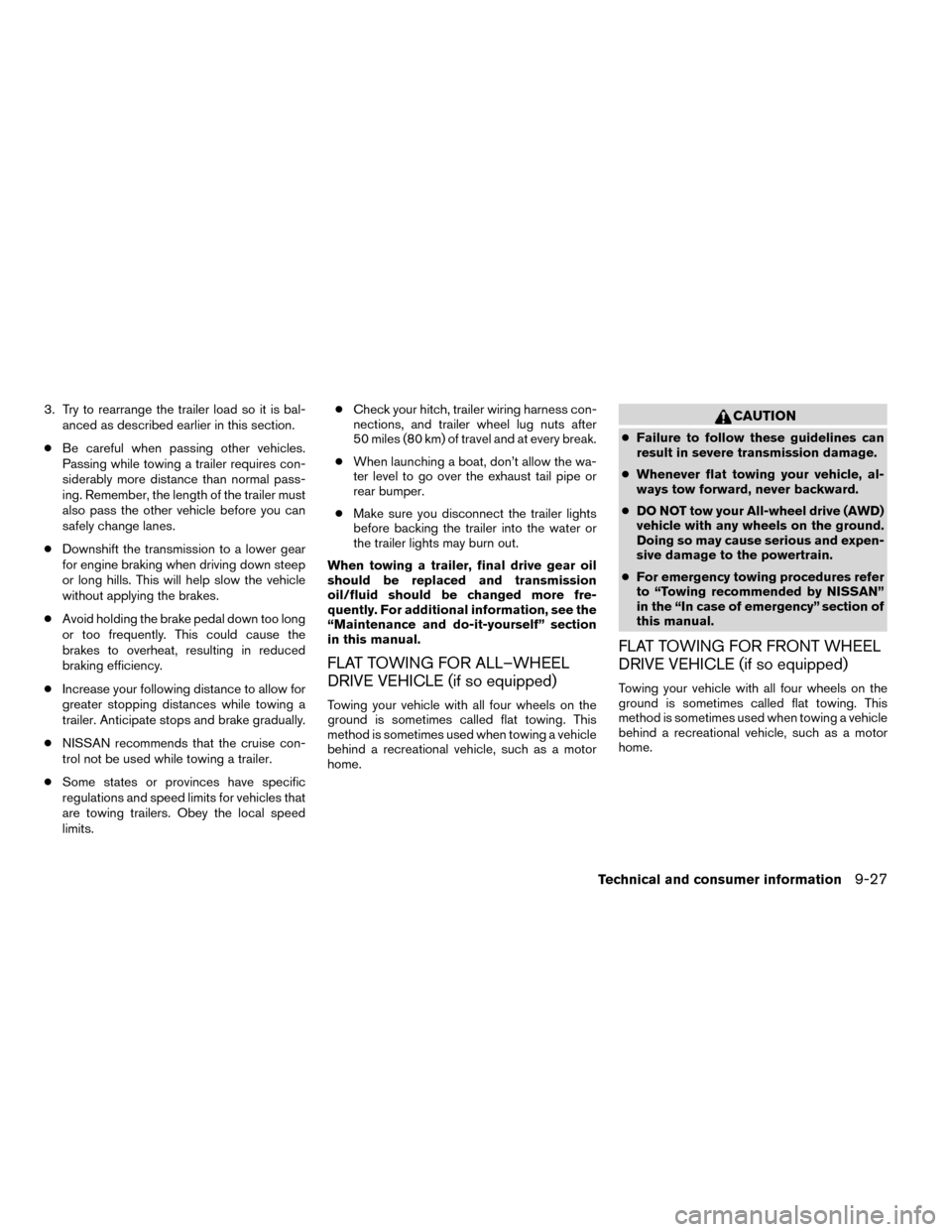
3. Try to rearrange the trailer load so it is bal-anced as described earlier in this section.
● Be careful when passing other vehicles.
Passing while towing a trailer requires con-
siderably more distance than normal pass-
ing. Remember, the length of the trailer must
also pass the other vehicle before you can
safely change lanes.
● Downshift the transmission to a lower gear
for engine braking when driving down steep
or long hills. This will help slow the vehicle
without applying the brakes.
● Avoid holding the brake pedal down too long
or too frequently. This could cause the
brakes to overheat, resulting in reduced
braking efficiency.
● Increase your following distance to allow for
greater stopping distances while towing a
trailer. Anticipate stops and brake gradually.
● NISSAN recommends that the cruise con-
trol not be used while towing a trailer.
● Some states or provinces have specific
regulations and speed limits for vehicles that
are towing trailers. Obey the local speed
limits. ●
Check your hitch, trailer wiring harness con-
nections, and trailer wheel lug nuts after
50 miles (80 km) of travel and at every break.
● When launching a boat, don’t allow the wa-
ter level to go over the exhaust tail pipe or
rear bumper.
● Make sure you disconnect the trailer lights
before backing the trailer into the water or
the trailer lights may burn out.
When towing a trailer, final drive gear oil
should be replaced and transmission
oil/fluid should be changed more fre-
quently. For additional information, see the
“Maintenance and do-it-yourself” section
in this manual.
FLAT TOWING FOR ALL–WHEEL
DRIVE VEHICLE (if so equipped)
Towing your vehicle with all four wheels on the
ground is sometimes called flat towing. This
method is sometimes used when towing a vehicle
behind a recreational vehicle, such as a motor
home.
CAUTION
● Failure to follow these guidelines can
result in severe transmission damage.
● Whenever flat towing your vehicle, al-
ways tow forward, never backward.
● DO NOT tow your All-wheel drive (AWD)
vehicle with any wheels on the ground.
Doing so may cause serious and expen-
sive damage to the powertrain.
● For emergency towing procedures refer
to “Towing recommended by NISSAN”
in the “In case of emergency” section of
this manual.
FLAT TOWING FOR FRONT WHEEL
DRIVE VEHICLE (if so equipped)
Towing your vehicle with all four wheels on the
ground is sometimes called flat towing. This
method is sometimes used when towing a vehicle
behind a recreational vehicle, such as a motor
home.
Technical and consumer information9-27
Page 434 of 442
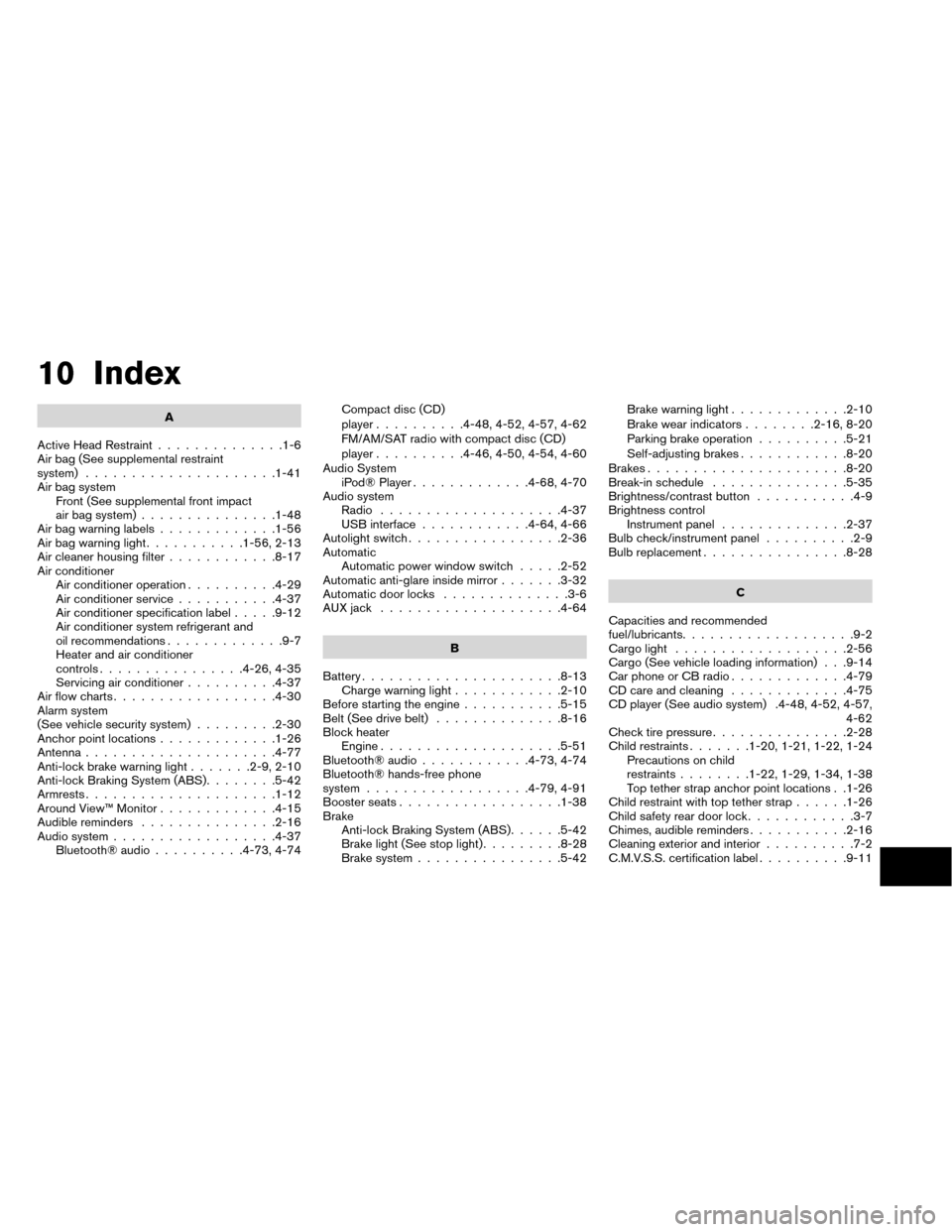
10 Index
A
Active Head Restraint ..............1-6
Air bag (See supplemental restraint
system) .....................1-41
Air bag system Front (See supplemental front impact
air bag system) ...............1-48
Air bag warning labels .............1-56
Airbagwarninglight...........1-56,2-13
Air cleaner housing filter ............8-17
Air conditioner Air conditioner operation ..........4-29
Air conditioner service ...........4-37
Air conditioner specification label .....9-12
Air conditioner system refrigerant and
oil recommendations .............9-7
Heater and air conditioner
controls................4-26,4-35
Servicing air conditioner ..........4-37
Airflowcharts..................4-30
Alarm system
(See vehicle security system) .........2-30
Anchor point locations .............1-26
Antenna .....................4-77
Anti-lock brake warning light .......2-9,2-10
Anti-lock Braking System (ABS) ........5-42
Armrests.....................1-12
Around View™ Monitor .............4-15
Audible reminders ...............2-16
Audio system ..................4-37
Bluetooth® audio ..........4-73,4-74 Compact disc (CD)
player
..........4-48,4-52,4-57,4-62
FM/AM/SAT radio with compact disc (CD)
player ..........4-46,4-50,4-54,4-60
Audio System iPod® Player .............4-68,4-70
Audio system Radio ....................4-37
USBinterface............4-64,4-66
Autolightswitch.................2-36
Automatic Automatic power window switch .....2-52
Automatic anti-glare inside mirror .......3-32
Automatic door locks ..............3-6
AUXjack ....................4-64
B
Battery......................8-13 Charge warning light ............2-10
Before starting the engine ...........5-15
Belt(Seedrivebelt) ..............8-16
Block heater Engine ....................5-51
Bluetooth® audio ............4-73,4-74
Bluetooth® hands-free phone
system ..................4-79,4-91
Booster seats ..................1-38
Brake Anti-lock Braking System (ABS) ......5-42
Brakelight(Seestoplight).........8-28
Brake system ................ 5-42Brakewarninglight.............2-10
Brake wear indicators
........2-16,8-20
Parking brake operation ..........5-21
Self-adjusting brakes ............8-20
Brakes ......................8-20
Break-in schedule ...............5-35
Brightness/contrast button ...........4-9
Brightness control Instrument panel ..............2-37
Bulb check/instrument panel ..........2-9
Bulb replacement ................8-28
C
Capacities
and recommended
fuel/lubricants ...................9-2
Cargolight ...................2-56
Cargo (See vehicle loading information) . . .9-14
Car phone or CB radio .............4-79
CD care and cleaning .............4-75
CD player (See audio system) .4-48, 4-52, 4-57, 4-62
Check tire pressure ...............2-28
Childrestraints.......1-20,1-21,1-22,1-24 Precautions on child
restraints........1-22,1-29,1-34,1-38
Top tether strap anchor point locations . .1-26
Childrestraintwithtoptetherstrap......1-26
Child safety rear door lock ............3-7
Chimes, audible reminders ...........2-16
Cleaning exterior and interior ..........7-2
C.M.V.S.S. certification label ..........9-11
Page 435 of 442
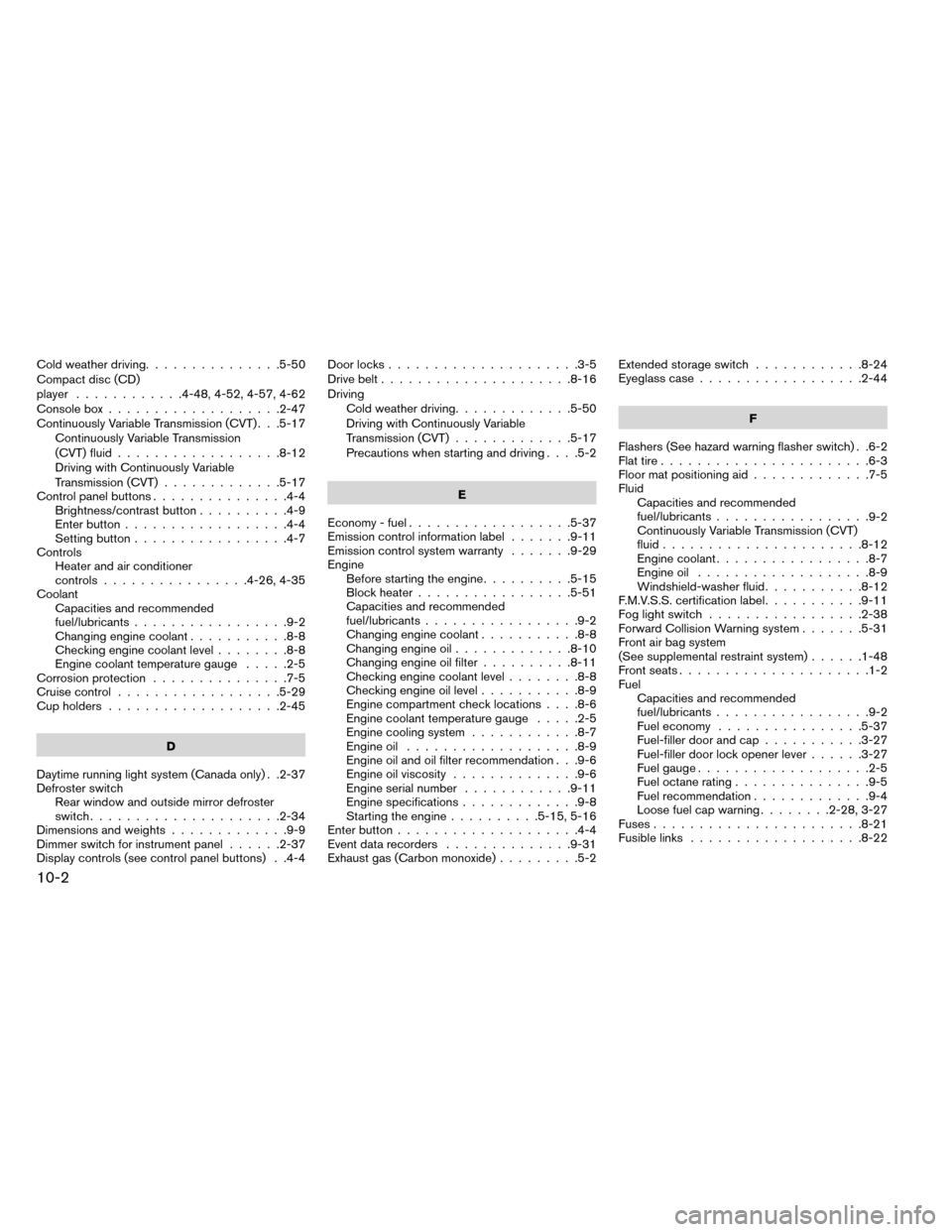
Cold weather driving...............5-50
Compact disc (CD)
player ............4-48,4-52,4-57,4-62
Console box ...................2-47
Continuously Variable Transmission (CVT) . . .5-17 Continuously Variable Transmission
(CVT) fluid ..................8-12
Driving with Continuously Variable
Transmission (CVT) .............5-17
Control panel buttons ...............4-4
Brightness/contrast button ..........4-9
Enterbutton..................4-4
Setting button .................4-7
Controls Heater and air conditioner
controls................4-26,4-35
Coolant Capacities and recommended
fuel/lubricants .................9-2
Changing engine coolant ...........8-8
Checking engine coolant level ........8-8
Engine coolant temperature gauge .....2-5
Corrosionprotection ...............7-5
Cruisecontrol..................5-29
Cupholders...................2-45
D
Daytime running light system (Canada only) . .2-37
Defroster switch Rear window and outside mirror defroster
switch.....................2-34
Dimensions and weights .............9-9
Dimmer switch for instrument panel ......2-37
Display controls (see control panel buttons) . .4-4 Door locks
.....................3-5
Drivebelt.....................8-16
Driving Cold weather driving .............5-50
Driving with Continuously Variable
Transmission (CVT) .............5-17
Precautions when starting and driving ....5-2
E
Economy - fuel ..................5-37
Emission control information label .......9-11
Emission control system warranty .......9-29
Engine Before starting the engine ..........5-15
Block heater .................5-51
Capacities and recommended
fuel/lubricants .................9-2
Changing engine coolant ...........8-8
Changing engine oil .............8-10
Changing engine oil filter ..........8-11
Checking engine coolant level ........8-8
Checking engine oil level ...........8-9
Engine compartment check locations ....8-6
Engine coolant temperature gauge .....2-5
Engine cooling system ............8-7
Engine oil ...................8-9
Engine oil and oil filter recommendation . . .9-6
Engine oil viscosity ..............9-6
Engine serial number ............9-11
Engine specifications .............9-8
Starting the engine ..........5-15,5-16
Enterbutton....................4-4
Event data recorders ..............9-31
Exhaust gas (Carbon monoxide) .........5-2Extended storage switch
............8-24
Eyeglass case ..................2-44
F
Flashers (See hazard warning flasher switch) . .6-2
Flat tire .......................6-3
Floormatpositioningaid.............7-5
Fluid Capacities and recommended
fuel/lubricants .................
9-2
Continuously Variable Transmission (CVT)
fluid......................8-12
Engine coolant .................8-7
Engine oil ...................8-9
Windshield-washer fluid ...........8-12
F.M.V.S.S. certification label ...........9-11
Foglightswitch .................2-38
Forward Collision Warning system .......5-31
Front air bag system
(See supplemental restraint system) ......1-48
Front seats .....................1-2
Fuel Capacities and recommended
fuel/lubricants .................9-2
Fuel economy ................5-37
Fuel-filler door and cap ...........3-27
Fuel-filler door lock opener lever ......3-27
Fuel gauge ...................2-5
Fuel octane rating ...............9-5
Fuel recommendation .............9-4
Loose fuel cap warning ........2-28,3-27
Fuses .......................8-21
Fusible links ...................8-22
10-2